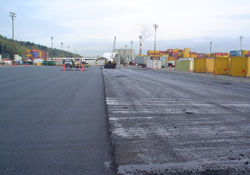by Katherine M. Dingman, Harbor Consulting Engineers, Incorporated
 Terminal 115, located just south of Seattle, Washington, is occupied by Northland Services, Incorporated – the Port of Seattle’s fourth largest tenant. On average, 57,000 tons of cargo is pushed through the terminal each month. When rehabilitation became necessary for this busy yard, special consideration was given to the alternatives assessed before deciding on a paving and pavement foundation method. A method of pavement rehabilitation known as full-depth reclamation, or FDR, proved to be the foundation method of choice as it provided greater strength and durability than most of the other pavement alternatives.
Terminal 115, located just south of Seattle, Washington, is occupied by Northland Services, Incorporated – the Port of Seattle’s fourth largest tenant. On average, 57,000 tons of cargo is pushed through the terminal each month. When rehabilitation became necessary for this busy yard, special consideration was given to the alternatives assessed before deciding on a paving and pavement foundation method. A method of pavement rehabilitation known as full-depth reclamation, or FDR, proved to be the foundation method of choice as it provided greater strength and durability than most of the other pavement alternatives.
Failed pavement surfacing due to excessive loading
Full-depth reclamation is a process in which the existing asphalt surface is pulverized in place and blended with the underlying base, subbase, and/or subgrade materials, mixed with portland cement, and compacted to provide a new stabilized base. A new surface course is then applied, which completes the FDR process, providing a new pavement structure using recycled materials from the failed pavement. For Terminal 115, full-depth reclamation was found to be the most cost efficient solution – especially when working through Seattle’s naturally wet environment.
Terminal 115 has a total yard space of 65 acres, with heavy lifting throughout and nearly 60 of those acres in need of repaving. A 3.5-acre full-depth reclamation trial repaving project took place in March and April of 2005. During the six weeks of construction, eight inches of rain fell in the Seattle area. Because of Seattle’s heavy precipitation, it is important that marine terminals carrying heavy loads be properly drained and resist pavement deflection. A properly designed FDR pavement was selected for this project as it could distribute large wheel loads to weak subgrade soils, maintaining a stable platform for many years. At Terminal 115, heavy equipment had destroyed the bituminous pavement surface and caused foundation deterioration. These failures led to safety and operating concerns as well as damage to equipment.
A section of the existing asphalt surfacing, stone base, and subgrade soils were pulverized and then blended together. Samples of this material were taken to a local materials laboratory where their maximum dry density and optimum moisture content were determined. Test specimens at 8, 10, and 12 percent portland cement by dry weight of this material were prepared, cured, and tested for unconfined compressive strength. This laboratory testing showed that 9 percent cement, incorporated into the pulverized and blended material, produced a consolidated base with a maximum dry density of 144.5 pounds per cubic foot (pcf) at 9.0 percent moisture, exceeding the three-day design strength requirement of 650 pounds per square inch (psi).
 Using information supplied by the Portland Cement Association, pavement design engineers recommended the use of 16 inches of FDR covered with six inches of new asphalt surfacing. M & M Road Recycle, Incorporated, Redmond, Washington performed the pulverization and incorporation of cement while S.C.I. Infrastructure, LLC, Pacific, Washington completed the compaction and grading.
Using information supplied by the Portland Cement Association, pavement design engineers recommended the use of 16 inches of FDR covered with six inches of new asphalt surfacing. M & M Road Recycle, Incorporated, Redmond, Washington performed the pulverization and incorporation of cement while S.C.I. Infrastructure, LLC, Pacific, Washington completed the compaction and grading.
New pavement next to FDR at Terminal 115.
An initial trial area used approximately 1,300 tons of cement – including some for wet weather modification of the subgrade soils. Because all design strength requirements were met or exceeded, an additional 15-acre site was proposed for rehabilitation using FDR and is anticipated to use approximately 6,000 tons of cement for full-depth reclamation including allowance for adverse weather construction.
In anticipation of wet weather, additional laboratory testing was conducted to ensure proper strength with increased cement content and higher soil moisture. This effort proved valuable during the spring of 2005. Testing determined that adding cement controlled the excess moisture and increased foundation strength, thereby allowing construction to continue during the adverse weather conditions. Exposing small areas to rainy weather prior to constructing the FDR helped to control foundation saturation and optimized cement utilization.
Minimal tenant disruption was essential. Full-depth reclamation saved both time and money. It solidified and stabilized the pulverized asphalt surfacing, stone base, and subgrade soils, and eliminated the need to export unusable materials. A reconstruction process that would have taken months was reduced to mere weeks, and the tenant resumed a new efficient operation quickly. By phasing and pre-staging construction, only small portions of the terminal yard were removed from the tenant’s operation at any given time.
The key to success at Terminal 115 was full time inspection and ongoing laboratory analysis. By combining the laboratory results from previous years including in-place testing and preparing additional laboratory specimens throughout construction proved much larger areas could be reconstructed than other options would allow. There can be little doubt that the use of FDR accelerated this project and reduced the downtime of the terminal.